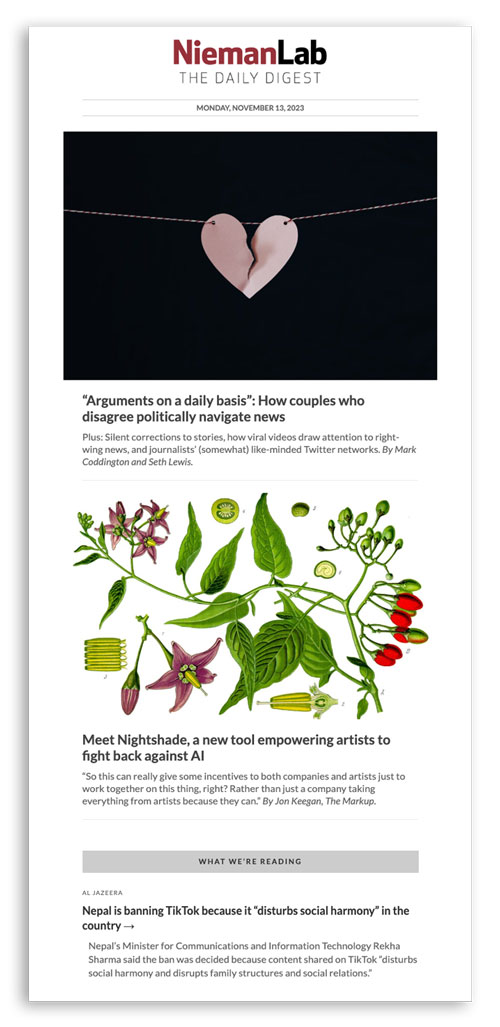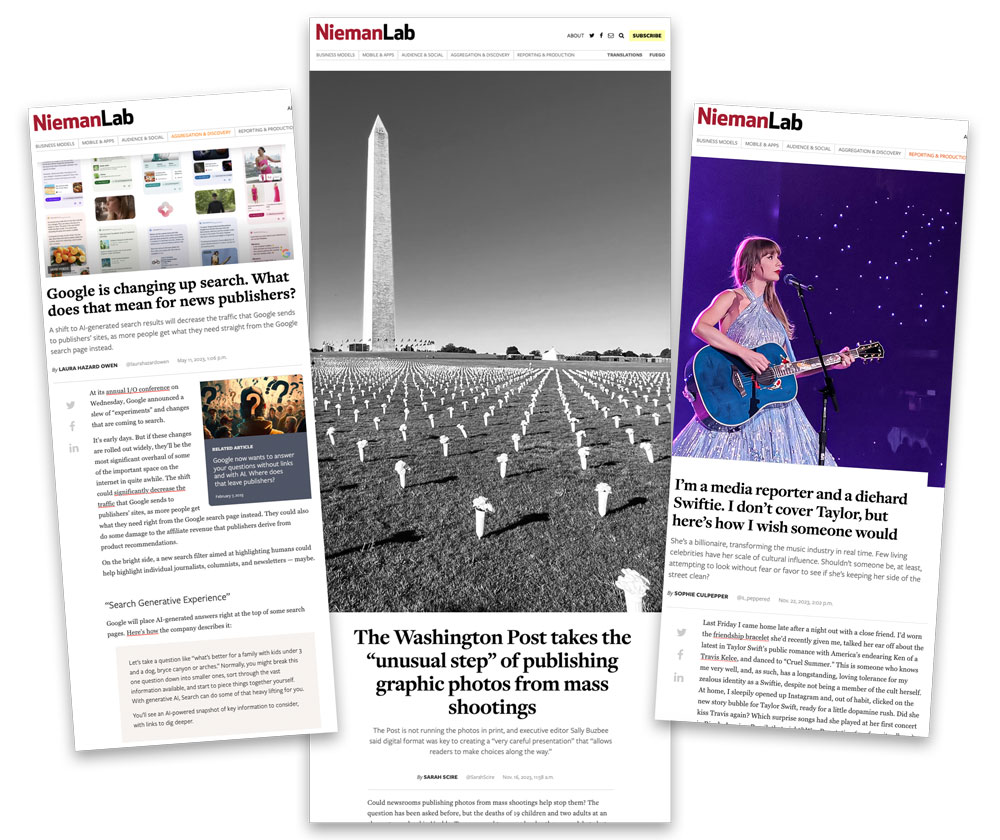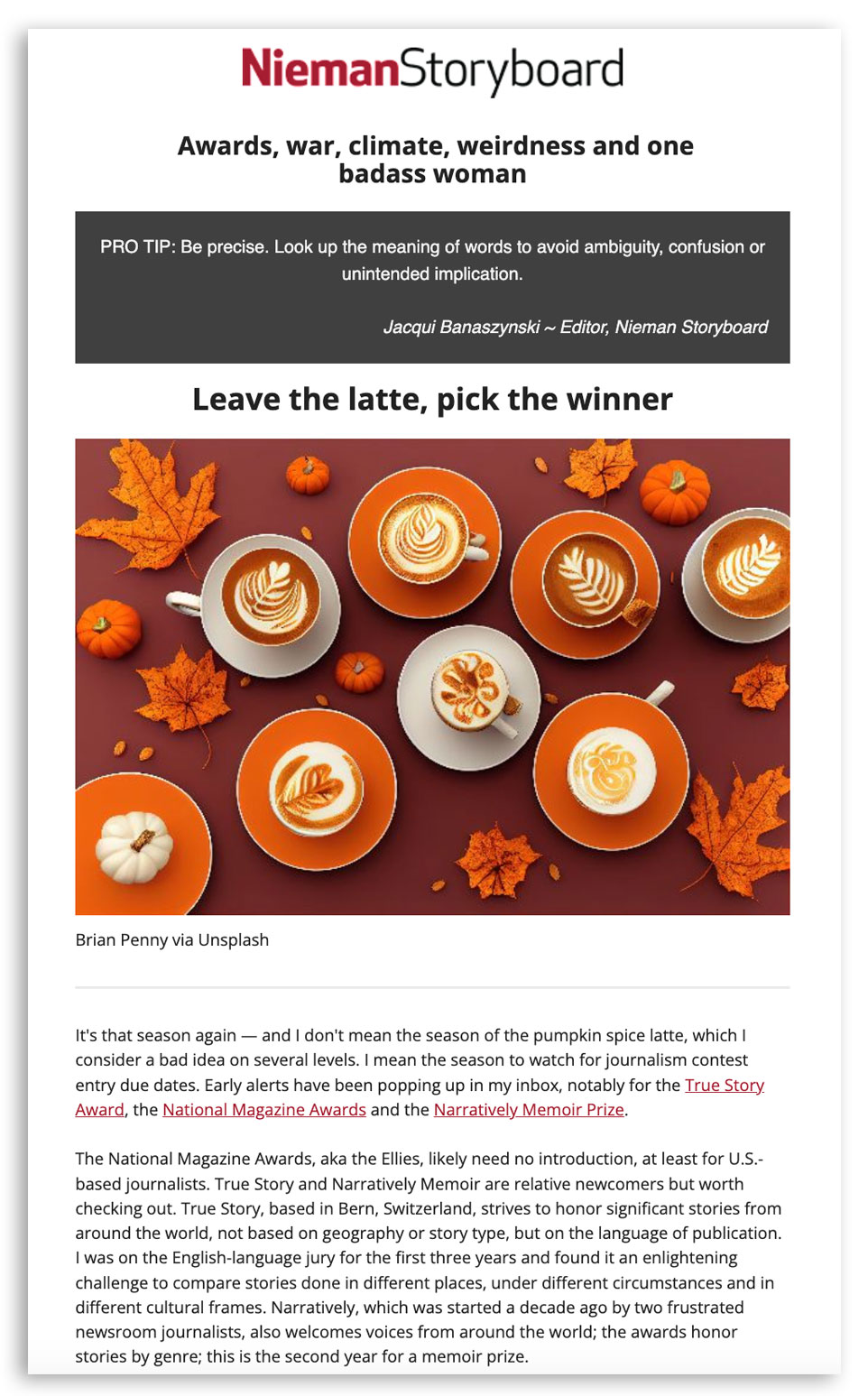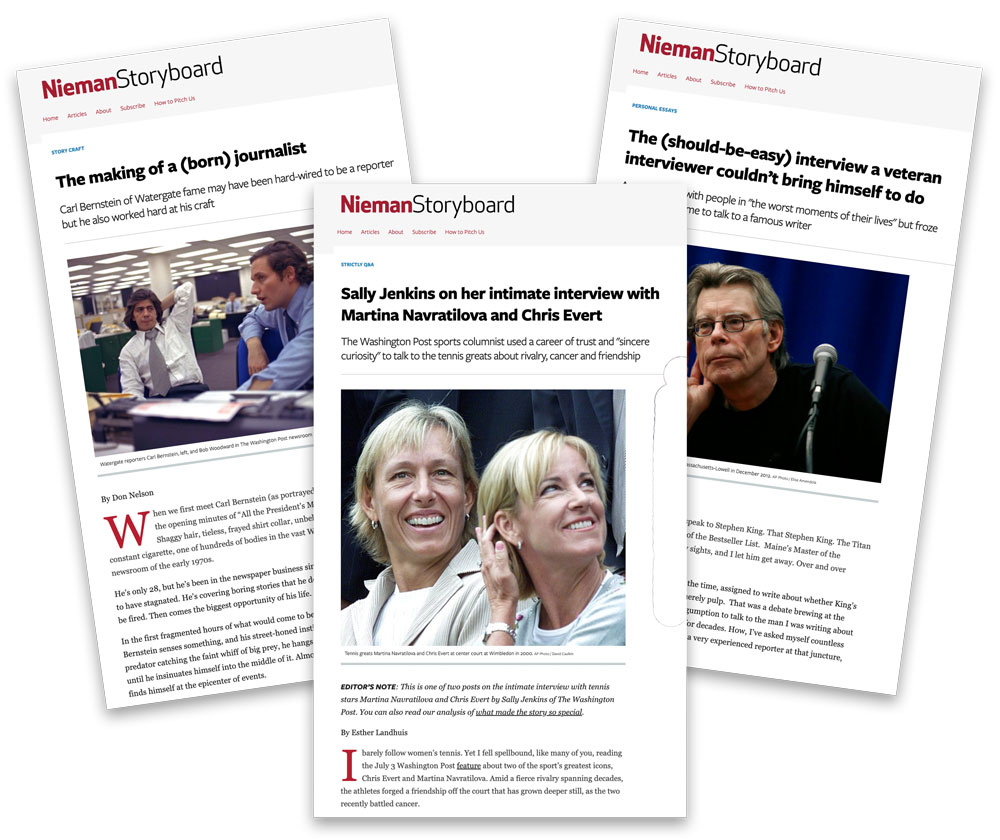Publications
Nieman Journalism Lab
The Nieman Journalism Lab serves as a vital resource for a global audience of readers and analysts seeking original reporting, research and commentary on important developments in the news and media industries. Established 15 years ago, the Lab today continues to provide incisive reporting about the future of news, innovation and best practices in the digital space.
Nieman Lab is now expanding to a full-time team of seven. We are in the final stages of hiring a staff writer to report on the intersection of generative AI and journalism as well as a new general staff writer. Sophie Culpepper, a staff writer focused on local news in the United States, joined us in April from the hyperlocal news site The Lexington Observer. Laura Hazard Owen is Nieman Lab’s editor, Sarah Scire is deputy editor, Joshua Benton is senior writer and Hanaa’ Tameez is a staff writer.
 Nieman Lab, like many news organizations, is thinking about creative ways to reach our audience as social platforms shift their focus away from news. Our most important social outreach platform is one we own and operate: email. This year, in addition to our daily newsletter, we revamped and relaunched our weekly newsletter to include original content and a curation of the best stories around the web. We expanded to new social platforms, including Threads, WhatsApp Channels, Bluesky and Mastodon, and can still be found on Twitter/X, Facebook, and LinkedIn. Combined, we have more than 500,000 followers across platforms.
Nieman Lab, like many news organizations, is thinking about creative ways to reach our audience as social platforms shift their focus away from news. Our most important social outreach platform is one we own and operate: email. This year, in addition to our daily newsletter, we revamped and relaunched our weekly newsletter to include original content and a curation of the best stories around the web. We expanded to new social platforms, including Threads, WhatsApp Channels, Bluesky and Mastodon, and can still be found on Twitter/X, Facebook, and LinkedIn. Combined, we have more than 500,000 followers across platforms.
Nieman Lab stories are regularly cited in leading publications. This year our coverage was mentioned by The New York Times, NPR, The Boston Globe, the Los Angeles Times, the Guardian, Vanity Fair, Slate, CNN, The Verge, n+1, Platformer and Today in Tabs, and was regularly featured in industry press outlets like Columbia Journalism Review, American Press Institute, Pew and Poynter.
In 2023, Lab members attended and spoke at the International Symposium on Online Journalism, the Transatlantic Leadership Network Conference on Freedom of the Media, the German American Conference at Harvard, the Ibero-American Summit of Public Media in Guanajuato, Mexico, and the IMEDD International Journalism Forum in Athens, Greece.
 Here’s a sampling of the top stories Nieman Lab published this year:
Here’s a sampling of the top stories Nieman Lab published this year:
- Google is changing up search. What does that mean for news publishers?
- The first newspaper strike of the digital age stretches into a new year
- No need to shoot The Messenger: Its muddled ideas are doing the job
- Can AI help local newsrooms streamline their newsletters? ARLnow tests the waters
- The Washington Post takes the “unusual step” of publishing graphic photos from mass shootings
- If other media companies thought about brand equity the way Elon Musk thinks about Twitter’s (er, X’s)
- How 13 news publishers are using WhatsApp Channels
- Five former journalists on why they left the industry
- I’m a media reporter and a diehard Swiftie. I don’t cover Taylor, but here’s how I wish someone would
- What a yarn! Journalists are turning to crochet to tell data stories
Areas of focus for 2024 will include the intersection of generative AI and journalism, the funding of nonprofit news, news organizations’ shifting relationships with platforms, continued consolidation in the digital news space and newsrooms’ expansions into non-news products.
The year ended, as it has each year since 2011, with a collection of predictions for the new year in journalism, written by a diverse group of smart digital thinkers and doers.
Nieman Reports
Journalism encountered a host of new challenges in 2023. Artificial intelligence experienced an explosion in popularity, prompting journalists to ask what the industry will look like as it evolves. After Elon Musk’s purchase of Twitter, now known as X, journalists are reimagining how to reach online audiences as the platform it once relied on for traffic continues to change substantively. Many are gearing up to report on what is likely to be another turbulent presidential election in the U.S. And all the while, the industry is grappling with many of the same issues it has dealt with in recent years, from the pressures faced by local news outlets to rampant disinformation and deteriorating press freedom worldwide.
This year, Nieman Reports, which has been covering thought leadership in journalism since 1947, published insightful, timely and deeply reported analyses of and commentary on these topics and more. This work appeared across four print issues, as well as online.
 In the Winter 2023 issue, “What Open-Source Journalism Reveals,” Maxim Edwards, an editor at Bellingcat, examined how open-source investigations (OSI) are becoming a mainstay in the digital age and gave us a glimpse into the newsrooms that have taken the lead in incorporating OSI into their reporting. The war in Ukraine is exemplary, Edwards writes, of journalists’ use of satellite imagery, social media posts and other publicly accessible sources to expose Russia’s crimes. Accompanying Edwards’ piece were three vignettes from journalists at Open Vallejo, The Washington Post, and The New York Times, who have published open-source investigations on topics like the 2021 Astroworld Festival crowd crush and police brutality. The magazine also featured stories on whether journalists should hold back scoops for their books, how reporters are fighting back against strategic lawsuits against public participation, and how Italian freelancer collectives are taking on ambitious investigative projects.
In the Winter 2023 issue, “What Open-Source Journalism Reveals,” Maxim Edwards, an editor at Bellingcat, examined how open-source investigations (OSI) are becoming a mainstay in the digital age and gave us a glimpse into the newsrooms that have taken the lead in incorporating OSI into their reporting. The war in Ukraine is exemplary, Edwards writes, of journalists’ use of satellite imagery, social media posts and other publicly accessible sources to expose Russia’s crimes. Accompanying Edwards’ piece were three vignettes from journalists at Open Vallejo, The Washington Post, and The New York Times, who have published open-source investigations on topics like the 2021 Astroworld Festival crowd crush and police brutality. The magazine also featured stories on whether journalists should hold back scoops for their books, how reporters are fighting back against strategic lawsuits against public participation, and how Italian freelancer collectives are taking on ambitious investigative projects.
 For her cover story in the Spring 2023 issue, “Journalism in Exile,” Celeste Katz Marston spotlighted the media outlets that are continuing to conduct vital reporting from outside their home countries. Setting up outposts in France, Thailand, Costa Rica and beyond, these journalists continue to hold the powerful to account despite the mounting threats to press freedom. Additionally, this issue features a robust collection of stories on local news: Catherine Buni writes about the states that are using public funding to support journalism; Marigo Farr interviews Harvard Kennedy School professor Thomas E. Patterson on how public radio can play a key role in reviving local news; and Ken Doctor, Tracie Powell, and Jim Friedlich offered their commentary on the Sunnylands convention on local news that took place in January. Laura Pérez Sanchez, a 2019 Nieman Fellow, wrote about independent media in Puerto Rico and Steven Greenhouse explained why rising temperatures should be reported on as a labor story.
For her cover story in the Spring 2023 issue, “Journalism in Exile,” Celeste Katz Marston spotlighted the media outlets that are continuing to conduct vital reporting from outside their home countries. Setting up outposts in France, Thailand, Costa Rica and beyond, these journalists continue to hold the powerful to account despite the mounting threats to press freedom. Additionally, this issue features a robust collection of stories on local news: Catherine Buni writes about the states that are using public funding to support journalism; Marigo Farr interviews Harvard Kennedy School professor Thomas E. Patterson on how public radio can play a key role in reviving local news; and Ken Doctor, Tracie Powell, and Jim Friedlich offered their commentary on the Sunnylands convention on local news that took place in January. Laura Pérez Sanchez, a 2019 Nieman Fellow, wrote about independent media in Puerto Rico and Steven Greenhouse explained why rising temperatures should be reported on as a labor story.
 In the age of ChatGPT and DALL-E, many have expressed concerns on the effects artificial intelligence will have on the industry. But as Gabe Bullard writes in his cover story for the Summer 2023 issue, journalists are also beginning to take advantage of AI to bolster their work, better engage their audiences, and expand their reach,. Also in this issue, “Why Retired Journalists Are Jumping Back into the Profession” by Jon Marcus highlights the journalists who have come out of retirement to kickstart new outlets, mentor younger journalists and fill the gaps left by a shrinking industry. Vidya Krishnan, a 2021 Nieman Fellow, reported on a billionaire’s hostile takeover of NDTV, one of the last channels in India willing to report critically on the Modi government, leaving few independent voices ahead of a critical election. Other stories include Stefania D’Ignoti’s piece on Syrian journalists who report in exile from Turkey and Celeste Katz Marston’s examination of how reporters are protecting their sources’ identities in the digital age.
In the age of ChatGPT and DALL-E, many have expressed concerns on the effects artificial intelligence will have on the industry. But as Gabe Bullard writes in his cover story for the Summer 2023 issue, journalists are also beginning to take advantage of AI to bolster their work, better engage their audiences, and expand their reach,. Also in this issue, “Why Retired Journalists Are Jumping Back into the Profession” by Jon Marcus highlights the journalists who have come out of retirement to kickstart new outlets, mentor younger journalists and fill the gaps left by a shrinking industry. Vidya Krishnan, a 2021 Nieman Fellow, reported on a billionaire’s hostile takeover of NDTV, one of the last channels in India willing to report critically on the Modi government, leaving few independent voices ahead of a critical election. Other stories include Stefania D’Ignoti’s piece on Syrian journalists who report in exile from Turkey and Celeste Katz Marston’s examination of how reporters are protecting their sources’ identities in the digital age.
Nieman Reports’ Fall 2023 issue commemorates the Nieman Foundation’s 85th anniversary with a collection of stories that Nieman Fellows first shared at the foundation’s celebration in October, all exploring “the story I couldn’t let go.”The fall edition also includes several feature stories: Jon Marcus looks at the fellowships, bootcamps and programs being developed for aspiring journalists of color; and Celeste Katz Marston breaks down what local news startups need to succeed.
This year, Nieman Reports also published a trove of online-only commentaries. Kendra Pierre Louis’ piece, “Three Years Later, Covid-19 Is Still a Health Threat. Journalism Needs to Reflect That,” argues that many news outlets are responsible not only for minimizing the health risks the virus still poses today, but also for amplifying narratives that pathologize people who are still Covid-cautious. Issac Bailey, a 2014 Nieman Fellow, continues to write his Nieman Reports column on journalism ethics, including a piece on The New York Times’ response to a letter from more than 1,000 of their contributors demanding better coverage of trans issues. And Gabe Bullard took a look at NPR six months after the organization left Twitter/X — and found that the impact on its traffic was negligible.
Under the direction of the Nieman Foundation’s digital and audience engagement editor Adriana Lacy, with assistance from Megan Cattel, Nieman Reports saw steady growth on its social channels in 2023. In addition to its print subscribers, Nieman Reports has more than 32,800 followers on Twitter/X, another 7,200 on Facebook and nearly 7,000 newsletter subscribers. Through new online efforts including Facebook ads, a more frequent publishing cadence on Instagram and more, Nieman Reports has experienced a nearly 20% increase in page views compared to the previous year.
The staff that produces Nieman Reports includes senior editor Laura Colarusso; assistant editor Natalie De Rosa; and publisher Ann Marie Lipinski, curator of the Nieman Foundation; with design by Dan Zedek, a Boston-based independent designer.
Nieman Storyboard
The first post on what is now Nieman Storyboard dates back 28 years, to 1995. The original site gained traction in the early 2000s as the Nieman Narrative Digest under the direction of founding editor Nell Lake. During that time, it drew from keynotes and workshops at the annual Nieman Narrative conferences and attracted a growing audience of nonfiction writers from the worlds of newspapers, magazines, books and education. As the baton passed to other top editors over the years, the site has expanded in both reach and content.
What started as short, expert summaries of recommended narrative nonfiction — often citing the early masters who published in known narrative magazines of the time — evolved into deep assessments of why those stories worked and how the best nonfiction writers and editors brought them to publication. When the Nieman narrative journalism conferences ended in 2009, the site was relaunched as Nieman Storyboard and became even more essential, serving as a resource and gathering place for staff and freelance journalists, educators and students who wanted to read and study the best of craft.
 Storyboard’s Friday newsletter now goes to 13,500 subscribers around the globe; almost 6,000 follow updates on X, and a similar number on Facebook. Even more come to the site through searches that hunt for expertise on reporting, writing, editing and stand-out coverage of hot topics. Storyboard has responded with a greater focus on SEO headlines and taglines.
Storyboard’s Friday newsletter now goes to 13,500 subscribers around the globe; almost 6,000 follow updates on X, and a similar number on Facebook. Even more come to the site through searches that hunt for expertise on reporting, writing, editing and stand-out coverage of hot topics. Storyboard has responded with a greater focus on SEO headlines and taglines.
Seismic changes in technology and the economy have challenged all forms of traditional journalism. Devotees of narrative nonfiction have been concerned that the work is especially vulnerable because it doesn’t conform to the tight frames of breaking news, civic coverage or bullet-point investigative projects. Nor can it be contained as quick-scan briefs or be counted on for reliable daily clicks. But just as Storyboard has endured and grown, so has the passion — on the part of journalists and readers alike — for human stories that are deeply reported and elegantly told, whether in print, audio or visuals.
One testament to that is the rise in the number of sites, newsletters, podcasts, lists and in-person events that feature in-depth literary nonfiction. All provide value. But most simply provide recommendations with links to great work. What continues to set Storyboard apart is adherence to its mission: Rather than simply collecting and noting stellar story work, it goes behind the scenes to unspool the processes, practices and people involved. Key examples from the past year:

- How veteran sports reporter and columnist Sally Jenkins of The Washington Post profiled the surprising friendship between Martina Navratilova and Chris Evert.
- A companion piece exploring why essays can be used to elevate journalism beyond information to explorations of the universal human experience.
- How a veteran reporter failed to land what should have been an easy interview.
- How another landed interviews that were almost impossible to get.
- How an academic writer learned to apply a concept from rhetoric to add intimacy and relevance to abstract or intellectual topics, and to speed/relax her work by free writing.
- How another academic gained a practical understanding of story ethics through a lesson from “Star Trek.”
- How Carl Bernstein of Watergate fame got to be Carl Bernstein.
- What a magazine editor and writing teacher learned from writing books, including an annotation of the book proposal that landed a contract after several earlier attempts failed.
The range of issues in the published pieces that Storyboard explores are often topical — gun violence, book bans, political and racial divides, the ongoing war in Ukraine. But they are chosen for the timelessness of the craft they demonstrate. Storyboard now reaches well beyond the world of narrative magazines into work being done in daily newspapers, partnerships between nonprofit and traditional newsrooms, in audio and visual reporting and even personal journalism. More needs to be done on those ever-changing fronts. And more needs to be done to explore the processes, values and story ethos at work as the Boomer and Gen X generations retire and the Millennial and Gen Z generations become the voices of today and tomorrow.
That will require more adaptation — more featured platforms, more contributor voices, more definitions of what makes compelling, essential narrative journalism. The Storyboard foundation that provides for that flexibility comes down to two primary things for the community: the best tools with which to practice their craft and the inspiration to use those tools.
Jacqui Banaszynski has been editor of Nieman Storyboard for five years. She was assisted in her work in 2023 by Nieman’s digital and audience engagement editor Adriana Lacy and by Natalie De Rosa, assistant editor of Nieman Reports.



